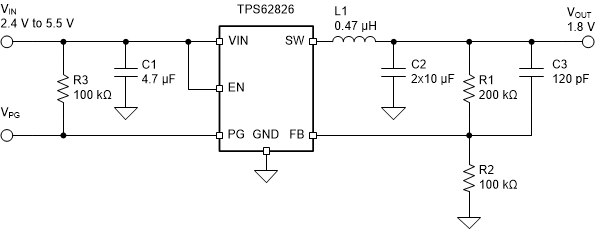SLVAET8 June 2020 TPS62810-Q1 , TPS62810M , TPS62811-Q1 , TPS62811M , TPS62812-Q1 , TPS62812M , TPS62813-Q1 , TPS62813M , TPS62824A , TPS62825 , TPS62825A , TPS62826 , TPS62826A , TPS62827 , TPS62827A
2.2 Fixed Frequency and Noise Control
In some applications, it may be desirable to best control the switching noise produced by the DC/DC converter, To keep it out of system-critical frequencies, for example, the AM radio band, or facilitate its filtering. While some versions of the TPS6282X family support forced PWM operation at light load, the DCS-Control™ topology is non-oscillator-based and its switching frequency can vary with changes in the application conditions as shown in Understanding frequency variation in the DCS-Control™ topology article. For noise control optimization, a fixed switching frequency topology DC/DC converter, similar to the TPS6281X as shown in TPS6281x-Q1 2.75-V to 6-V Adjustable-Frequency Step-Down Converter data sheet, can be the better choice to power VCCINT_VCU.
 Figure 4. Typical TPS6281X Application Circuit
Figure 4. Typical TPS6281X Application Circuit Table 2. Switching Frequency Settings Example Table for TPS62810-Q1
| RCF | Switching frequency | Min count (Vout <1 V) |
|---|---|---|
| 10kΩ to 4.5kΩ | 1.8MHz (10kΩ) to 4MHz (4.5kΩ) | 53µF |
| 33kΩ to 15kΩ | 1.8MHz (33kΩ) to 4MHz (15kΩ) | 100µF |
| 100kΩ to 45kΩ | 1.8MHz (100kΩ) to 4MHz (45kΩ) | 200µF |
| tied to GND | Internally fixed at 2.25 MHz | 53µF |
| tied to VIN | Internally fixed at 2.25 MHz | 200µF |
The TPS6281X is 2.75-V to 6-V input step-down converter pin-to-pin family supporting output currents ranging from 1-A to 4-A and available in a 3-mm x 2-mm VQFN package. The switching frequency is fixed and externally adjustable from 1.8-MHz to 4-MHz using a RCF resistor connected to the COMP/FSET pin. It can also be synchronized to an external clock in the same frequency range. The feedback voltage accuracy is specified to 1% over the whole junction temperature range of –40°C to 150°C.